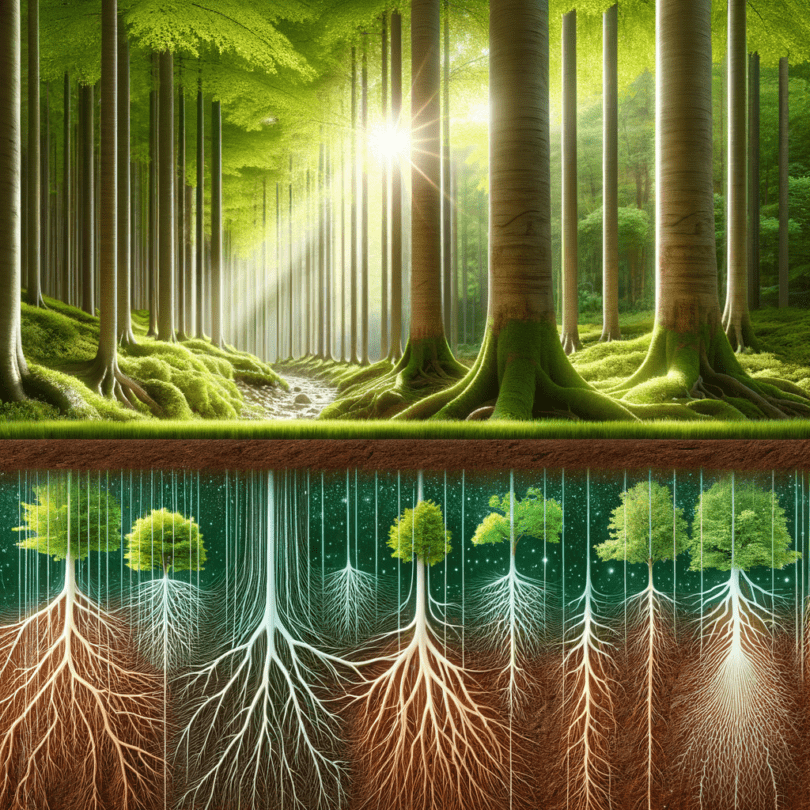Imagine, if you will, the simple pleasure of wandering through a dense, whispering forest, where each breath of fresh, earthy air spins tales of ancient secrets. Light sprinkles through the branches, dappling the forest floor, and if you let your imagination wander just a little further, you’ll find a whole world hidden underfoot. This world is quite literally beneath us—a tangled universe of roots, teeming with life, that’s as mysterious as it is silent. It’s like a miniature city, where trees, those towering sentinels, communicate in whispers.
Isn’t it kind of delightful to imagine that trees might “chat” among themselves, like old neighbors across garden fences? Picture them sharing musings on yesterday’s rain, strategizing their survival plans, and maybe even grousing a bit about a troublesome squirrel or two. Of course, they’re not having coffee-filled chats as we do. Their language, oh my, it’s a far dance more intricate—woven through the threads of chemical signals, electric pulses, and the subtle movements of fungal networks. It’s like nature’s own morse code.
And speaking of that, the real stars of this underground saga? Well, they’re not just trees. It’s the “Wood Wide Web.” Don’t you just love the whimsy of that term? It sends my mind spinning back to childhood and fairy tales filled with talking forests and magical creatures.
The Underground Orchestra
Ah, yes, the unsung heroes here are the mycorrhizal fungi. These cool little guys form symbiotic relationships with tree roots, and let me tell ya, it’s like nature’s version of making a deal at the playground—”I’ll trade you sugars for nutrients!” They ensure that every tree has what it needs, even if the conditions are a bit rough. If I stretch my imagination a bit—picture each tree having its very own butler, bustling about to make sure everything’s just right.
How fascinating is that? The fungi almost play the ultimate supporting role, making sure that every tree in this leafy network gets its chance at survival, growth, and yep, communication, too.
Trees in Conversation: A Nonverbal Exchange
Now, here’s where the trees sort of get their “voice.” This isn’t about small talk; it’s life and death stuff. When a tree senses danger—a pest nibbling away or a disease on the prowl—it sends out a nifty SOS through chemicals. Other trees get the memo and start their defense mechanisms. It’s like a heads-up in a group chat: “Hey, better grab your raincoats; there’s a storm coming!”
This level of concern and “looking out for a buddy” among trees? It gets me right in the feels. There’s something pure and lovely in that, isn’t there? Perhaps a side lesson for us humans in there, one we should be taking notes on under the shade of our leafy companions.
But it’s not all about threats. When the going’s good, trees can even share their bounty. Picture a struggling tree getting a little help from its friends. Though we tend to see a forest as individual trees, if you peek underground, it’s a deeply connected society.
Identity and Community: The Mother Trees
Oh, and then there’s the concept of “Mother Trees.” Now, this really caught my heart. These trees are the wise elders of the forest, with networks sprawling so far-reaching it seems they’re practically holding the whole forest together. They help distribute resources and, dare I say, possibly some ancient tree wisdom, nurturing the younger generations.
It’s almost like envisioning our grandmothers, who share family tales and wisdom while passing around a meal. If only those roots could tell their stories like we do!
A Tangible Network in a Digital Age
Sometimes I think about our current world, so connected yet so distant. And then I stumble upon this glorious, living network underfoot that’s been around long before our WiFi connections. It’s alive and pulsing, carrying messages, nurturing them along its earthy highways.
The Wood Wide Web is quite the tour de force—a community built on solid values like resilience, resourcefulness, and reciprocity, unlike the fleeting digital bubbles we often find ourselves in.
Grounding, isn’t it? It reminds me of that primitive, timeless web of life—felt, seen, and understood through the lens of nature’s genius.
The Complexity of Nature and Our Place in It
Every layer of this underground marvel is filled with complexity we’re only starting to wrap our heads around. It’s a compelling nudge to reevaluate what we think we know about intelligence and community. Turns out, trees might have got some of this figured out long before we did!
It’s humbling, to say the least. We often rely on equations and boxed definitions, but the poetry of nature’s complex web reminds me there’s so much more under the sun (and soil).
Maybe it all speaks to our own longing for community, belonging, and living harmoniously as part of something bigger, just as trees seamlessly meld into the forest floor through invisible threads.
To Listen to the Whispers
With all our digital noise, I find myself longing for simplicity—the kind that comes with understanding tree talk. It challenges us to re-imagine a future where collaboration is as essential as the breath we draw.
So, maybe next time you’re out for a stroll in the woods (I highly recommend it), take a pause. Imagine the whispers of roots weaving tales below, older and wiser than ours. Soak in their silent wisdom, and perhaps they’ll whisper back, teaching us a little about the intricate, gorgeously tangled web of life we all share.
The unassuming grace of their wisdom, weaving quietly in communal strength, invites us to listen closely, to connect, and to realize that perhaps the richest wisdom lies in the trees’ whispered secrets.

